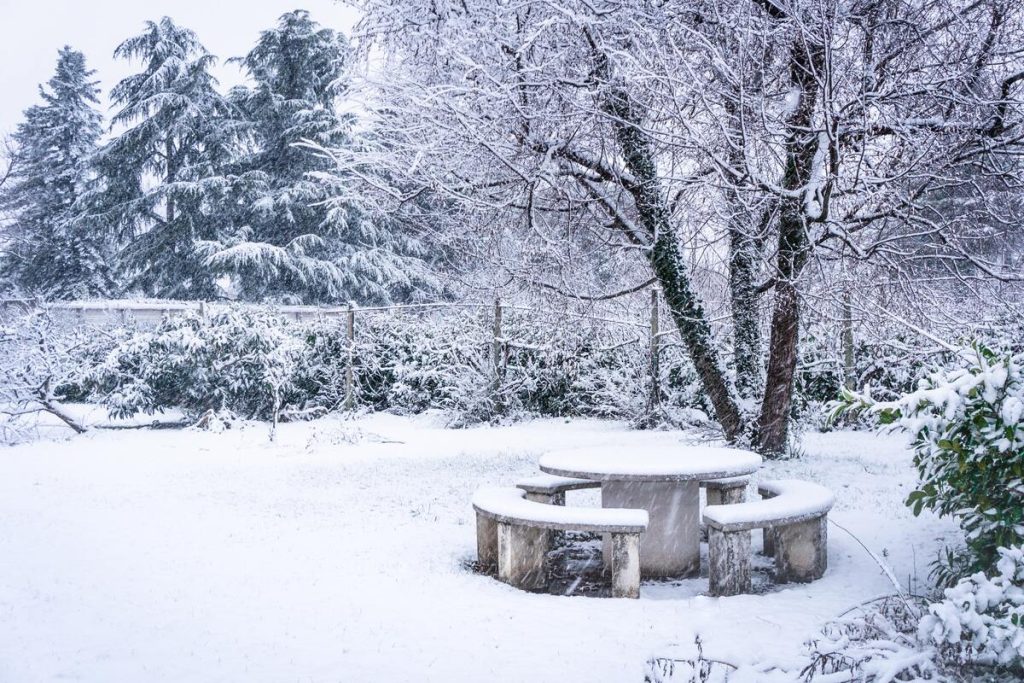Winter can be challenging for backyard maintenance, especially considering the average winter temperature reaches 33 Fahrenheit in the United States. From frozen plants and snow-covered lawns to ice-encrusted walkways, plenty of problems can arise in your backyard during the colder months. But don’t worry, here’s a rundown of some of the most common wintertime backyard issues and how to solve them.
Frozen Plants and Trees
When it comes to cold-weather gardening issues, frozen plants are at the top of the list. To protect your shrubs, trees, and other foliage from freezing temperatures, make sure they have enough water throughout the winter.
You’ll also want to cover them with burlap or blankets if temperatures dip below freezing for extended periods. If you end up with frozen plants or trees, try not to worry; as long as their roots are still alive, most plants will recover in springtime and their expected growth patterns.
Additionally, make sure to trim them when you can. Untrimmed branches often break more easily in cold weather, especially if they are weighed down by ice or snow. If you don’t want to do any of these things, consider hiring a local tree service to help you out. The service can trim the trees, take care of the plants, and even remove any branches or limbs that are still frozen.
Snow Buildup
Snow is a problem in certain states during the winter. Certain states, like Maine, get 77 inches of snow annually. That’s why snow buildup is one of the most common outdoor problems people face during cold weather. When snow accumulates in large amounts, it can cause damage to your home’s foundation and roof. It can also damage water as the snow melts and refreezes on surfaces, allowing ice dams to form.
The best way to prevent or mitigate damage from snow buildup is to clear it off surfaces immediately after falling. Investing in a good quality shovel and snow blower can help keep your yard clear throughout the winter. Another way to get rid of snow buildup is to use a de-icing agent. De-icing agents, such as those made with salt or sugar (some even use kitty litter), melt ice and help prevent it from building up.

Signs of Wear and Tear
Cold weather can also take its toll on your home’s exterior walls, windows, doors, and other structures located in your backyard. Pay close attention to signs of wear and tear as temperatures drop, such as cracks or holes in walls or windowsills that may need repair or replacement. If left unaddressed, these issues could become severe over time due to exposure to the elements—including wind, rain, sleet, snow, and more—as well as potential animals nesting inside these areas if they are not adequately secured.
Water Pipes
Freezing temperatures can also be detrimental to your water pipes. In the winter, water expands as it freezes. If you have a pipe that’s already frozen, the expansion can cause it to burst—leaving you with significant problems in your home. To prevent this from happening, insulate your pipes and keep them at room temperature. You can also turn off the water in the basement or crawl space if you’re worried about vulnerable pipes in these areas of your home.
Snow-Covered Lawns
Having a snow-covered lawn during winter is inevitable in many regions. While this may seem an issue at first glance, it can benefit your turfgrass since it protects from frost heaving and provides insulation against extreme cold weather conditions. Plus, if you get enough snowfall throughout the winter, you won’t need to worry about watering your grass until spring arrives—which is one less task on your yard maintenance chores!
Ice-Encrusted Walkways
Nobody wants a slippery path leading up to their front door—so what can be done? The best way to prevent icy walkways is to remove snow regularly with a shovel or snow blower (or hire someone else to do it!).
You should also spread sand or salt on your pathways before any significant snowfall takes place—this will help melt existing ice patches and prevent new ones from forming in the future. Additionally, ensure all outdoor lighting near walkways works correctly so visitors don’t stumble in the dark!
Winter can be a difficult season for yard maintenance—but it doesn’t have to be! By tackling these standard backyard problems head-on through proactive measures such as watering plants before temperatures drop too low and salting pathways before major snowstorms roll in, you’ll save yourself lots of trouble later on down the line. With just a bit of preparation and know-how, you’ll turn those wintertime blues into summertime smiles in no time!




